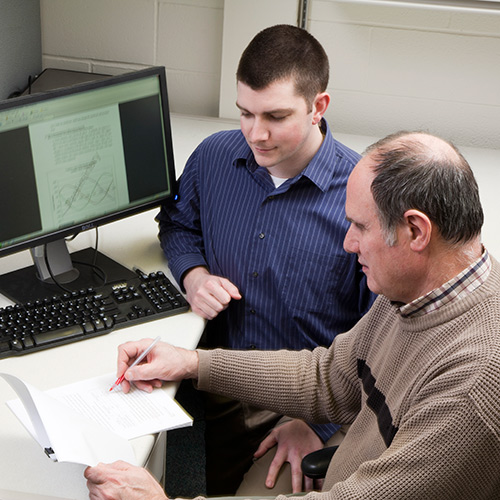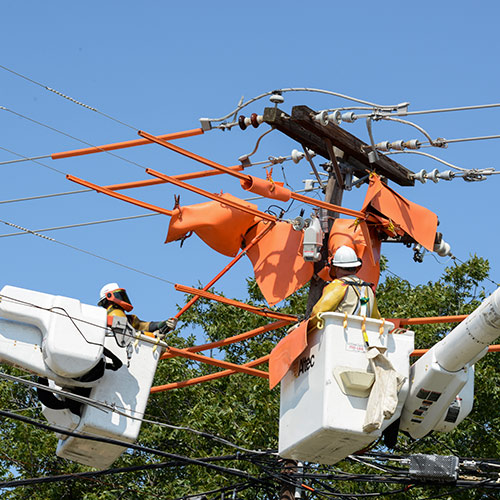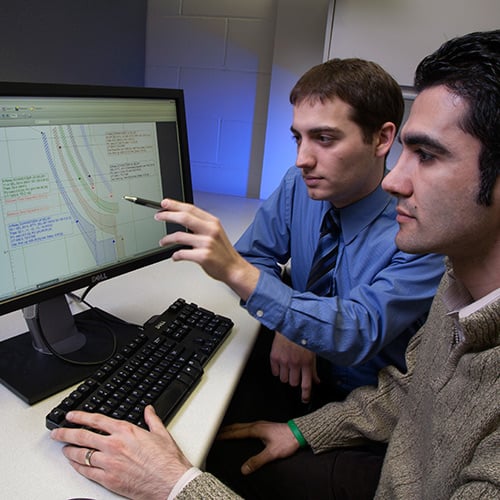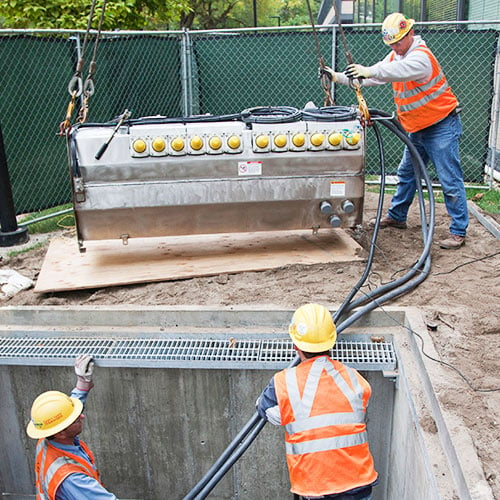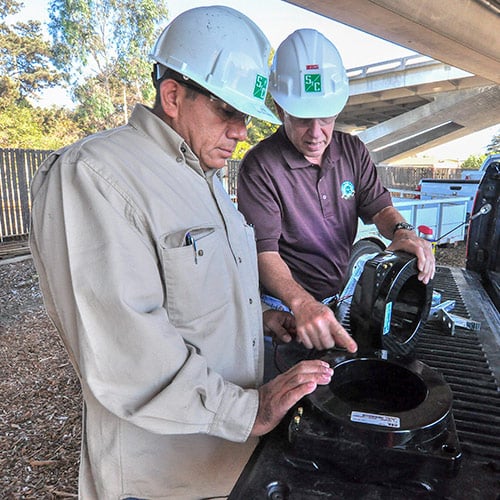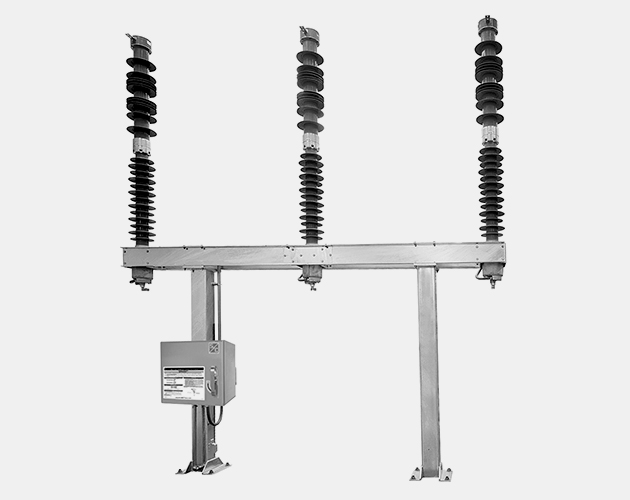
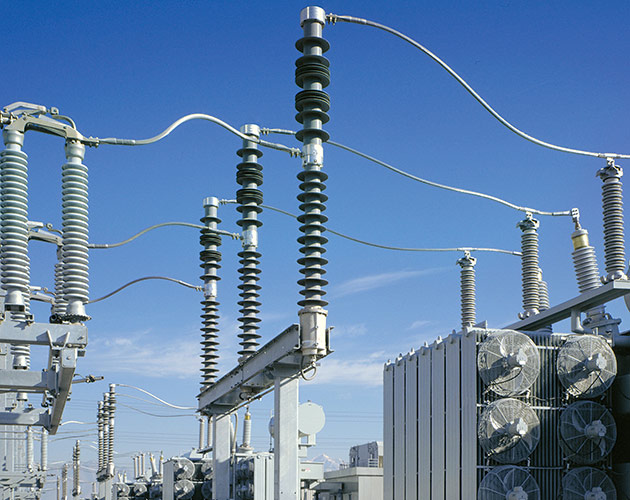
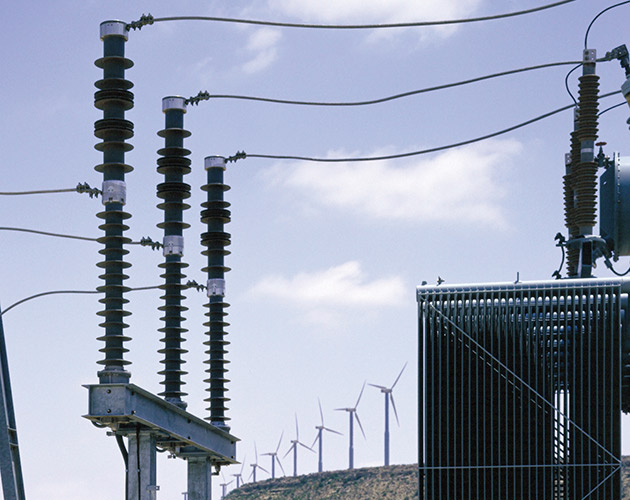
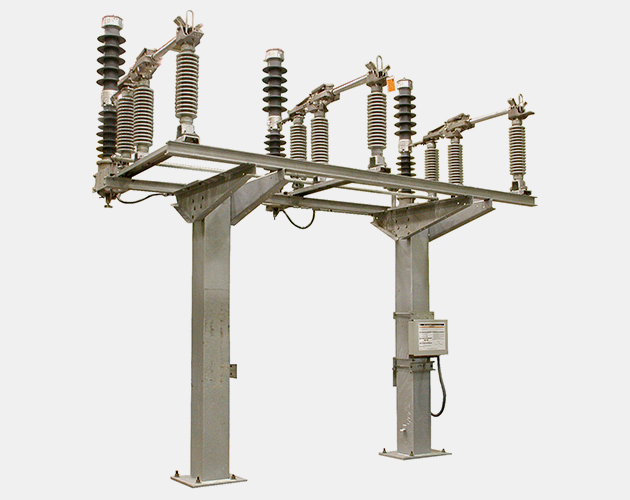
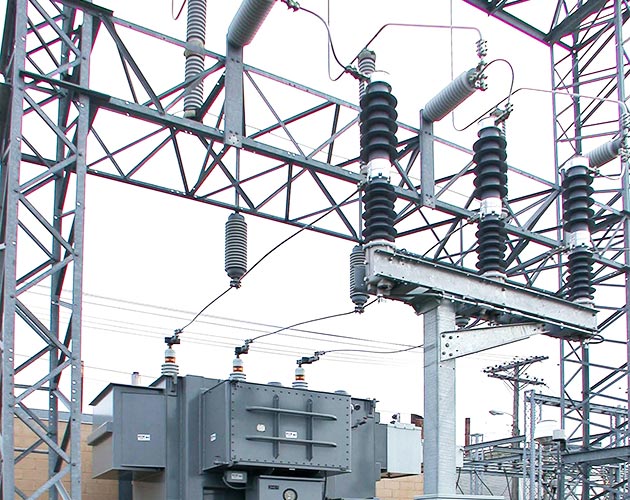
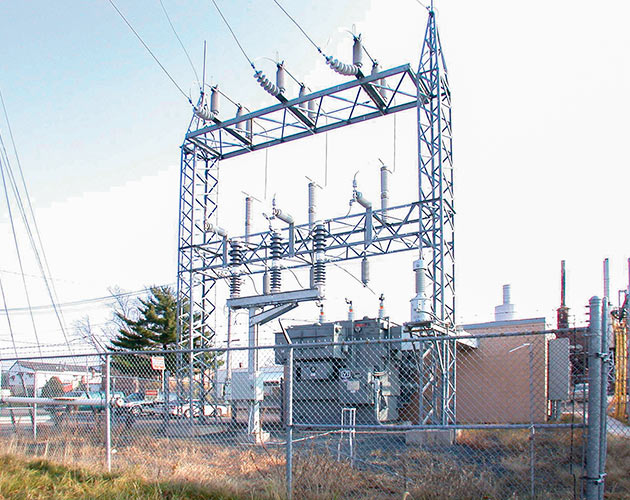
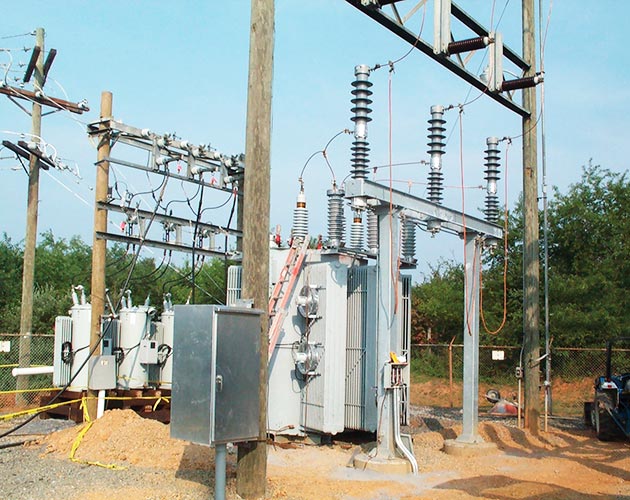
Trans-Rupter II® Transformer Protector
The low-cost solution for sophisticated transformer protection
Designed exclusively for primary-side application on distribution substation transformers, where operation is infrequent and continuous-current requirements are modest
Electric utilities face ever-increasing demands to reduce costs and improve reliability. Until now, these goals were mutually exclusive when it came to transformer protection. You could either select a higher-cost transformer switch with advanced protection capabilities, such as a circuit-switcher or circuit breaker, or you could choose a lower-cost device with limited protection capabilities, such as power fuses or a high-speed ground switch.
But now there’s a device that meets both goals. S&C’s Trans-Rupter II Transformer Protector is designed exclusively for primary-side protection applications on distribution substation transformers. It gives you all the features you need for reliable transformer protection, and it eliminates those you don’t. With its simple installation procedure and no periodic maintenance needs, the Trans-Rupter II Transformer Protector not only ensures low installed cost, but low operating costs as well.
Construction Features
- Three-phase tripping by electrically linked pole-units. Trans-Rupter II provides simultaneity of less than 1/4 cycle. There’s no mechanical linkage to adjust or maintain.
- Resettable pole-units. Unlike power fuses, Trans-Rupter II simply needs to be manually closed and charged after an operation.
- Hermetically sealed pole units. SF6-gas-filled pole units are filled to full pressure at the factory, then permanently sealed. Field filling is never needed.
- Single-gap SF6 puffer-type interrupters provide a 3-cycle interrupting time and maintain dielectric ratings when open.
- Shatterproof composite-polymer silicone insulation. Stands up to the most severe environment. Unique skirt arrangement on 115-kV and 138-kV pole-units provides enhanced dielectric performance.
- Maintenance-free operating mechanism. Each Trans-Rupter II pole-unit includes its own operating mechanism, sealed in SF6for excellent protection from the environment.
Compare Trans-Rupter II’s features to those of other transformer protective devices:
| Feature | Power Fuses | Circuit-Switchers | Circuit Breakers | Trans-Rupter II Model EX |
Trans-Rupter II Model SE |
|---|---|---|---|---|---|
| Three-Phase Tripping | ☑ | ☑ | ☑ | ☑ | |
| Activated by Relays | ☑ | ☑ | ☑ | ☑ | |
| Resettable | ☑ | ☑ | ☑ | ☑ | |
| High Interrupting Ratings | ☑ | ☑ | ☑ | ☑ | |
| SCADA Compatibility | ☑ | ☑ | ☑ | ☑ | |
| No Substation Batteries | ☑ | ☑ | |||
| Mounting Flexibility | ☑ | ☑ | ☑ |
Interrupter Ratings — Model EX and Model SE
| kV | Amperes, RMS | Interrupting Time, Cycles, Max. | ||||
|---|---|---|---|---|---|---|
| Nom. | Max. | BIL | Cont. | Primary Faults, Sym. | Secondary Faults | |
| 69 | 72.5 | 350 | 420 | 31 500 | 4 200 | 3 |
| 115 | 123 | 550 | 420 | 31 500 | 2 600 | 3 |
| 138 | 145 | 650 | 420 | 31 500 | 2 600 | 3 |
Interrupter Ratings — Cold Temperature Model EX
| kV | Amperes, RMS | Interrupting Time, Cycles, Max. | ||||
|---|---|---|---|---|---|---|
| Nom. | Max. | BIL | Cont. | Primary Faults, Sym. | Secondary Faults | |
| 69 | 72.5 | 350 | 420 | 31 500 | 4 200 | 3 |
| 115 | 123 | 550 | 420 | 31 500 | 2 600 | 3 |
| 138 | 145 | 650 | 420 | 31 500 | 2 600 | 3 |
At temperatures between -35°C and -50°C, the primary-side fault interrupting rating is 10,000A. A 2-cycle time-delay relay is required to attain the 10 000A primary-side fault interrupting rating.
At temperatures between -35°C and -50°C, the secondary-side fault interrupting rating is 650A.
At temperatures between -35°C and -50°C, the secondary-side fault interrupting rating is 950A.
Tripping
On Model EX, the pole-units are electrically tripped by a user-furnished relay. On Model SE, the pole-units are electrically tripped by the self-powered overcurrent protection system.
Closing
A source-side, three-pole, group-operated disconnect switch is required to provide visible air-gap isolation after the interrupters have been tripped, and to pick up transformer magnetizing inrush current after pole-units have been reset.
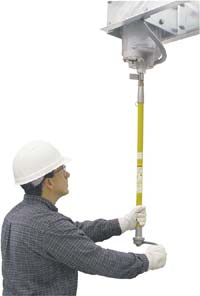
Rotate the charging tool handle counterclockwise to close and charge a pole-unit.
Trans-Rupter II Transformer Protector is available in two versions: Model EX is tripped from user-furnished overcurrent, differential, or sudden-pressure relays. Model SE is tripped from its own self-powered overcurrent protection system.
Trans-Rupter II Model EX
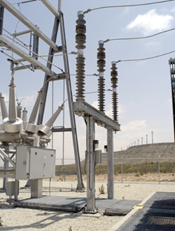
Model EX is perfect for substation where control power and relays are already in place. It’s especially suited for retrofitting overdutied circuit breakers or circuit-switchers . . . or for updating transfer-trip, flash-bus or high-speed grounding switch transformer protection schemes.
Model EX is compatible with virtually any user-furnished differential, sudden-pressure, or overcurrent relay. Pole-units are field-wired to a low-voltage connection enclosure for connection to user-furnished relays and control power. Model EX requires a user-furnished 48-Vdc or 125-Vdc control-power source.
Motor operators are optionally available for Model EX and provide remote resetting capability. The operators mount under the Trans-Rupter II pole-units. They’re easy to install and are removable for manual closing and charging in the event control power is lost. No heaters are required.
Trans-Rupter II Model SE
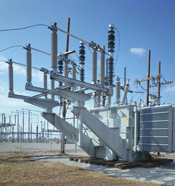
Model SE features a self-powered overcurrent protection system activated by the current transformers on the primary bushings of the transformer. The Model SE is ideal for retrofitting power fuse installations and for new substation construction . . . saving the cost of substation batteries, relays and even the control house!
The three microprocessor-based, self-powered overcurrent relays and the trip-energy supply are housed in a weatherproof control cabinet that mounts easily on most substation structures. The relays provide both time-overcurrent and instantaneous-overcurrent protection, and are field-settable with adjustable time delays.
Model SE Overcurrent Protection System
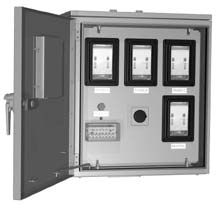
The overcurrent relays provide both time-overcurrent and instantaneous-overcurrent protection. They’re field-settable with adjustable time delays. The time-overcurrent function includes 10 time-current-characteristic curves, including inverse, very inverse, and extremely inverse curves, in accordance with IEEE and IEC standards. Relay operating time is two cycles. Combined with Trans-Rupter II’s 3-cycle interrupting time, Model SE provides a total fault-clearing time of 5 cycles.
Sensing for the overcurrent relays, as well as power for the trip-energy supply, is provided by the transformer primary-side current transformers. A manual trip device, which provides the energy to trip all three pole-units if the line is de-energized, is also included.
Trans-Rupter II Retrofit Kits for Mark II through Mark V Circuit-Switchers
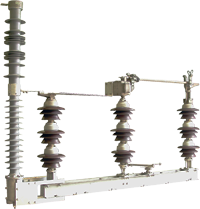
With the high level of electric service reliability demanded today, many older substations require major equipment upgrades. But such upgrades can be extremely costly. And the available real estate and access needed to install new equipment are often limited.
Now there's an economical way to upgrade S&C Mark II through V Circuit-Switchers in transformer-protection applications: retrofit kits featuring S&C Trans-Rupter II Transformer Protector. The Trans-Rupter II pole-units mount directly to the Circuit-Switcher bases and provide enhanced transformer protection. The blade assemblies of the Circuit-Switcher are retained to provide a source-side series disconnect. Retrofit kits include all mounting brackets and hardware needed to complete the installation.
Model EX Motor Operator Option
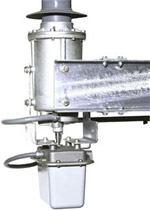
The Trans-Rupter II Transformer Protector Model EX offers and innovative and economical solution for substation transformer protection. Now there's an easy and cost-effective way to add remote-resetting capability to the Trans-Rupter II Model EX. Introducing the motor operator option.
Quick-Connect Control Cable
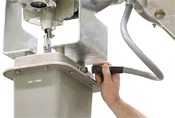
The optional quick-connect control cable replaces the conduit normally supplied with S&C Mounting Pedestals, and features Amphenol® Tri-Start Connectors. These moisture and corrosion-resistant connectors lock with an easy turn of the coupling nut. They simplify connections at each pole-unit and the Model EX low-voltage enclosure or Model SE control cabinet . . . saving valuable installation time and ensuring proper wiring. A quick-connect control cable is also available for the optional motor operators for Trans-Rupter II Model EX.
A Resource for Selecting a Substation Transformer Protective Device
One criterion in selecting a distribution substation transformer protective device is its ability to protect the transformer from secondary-side limited faults . . . or “through-faults.” These faults are difficult to detect by the overcurrent relay of the line-terminal circuit breaker, because the magnitude of the fault current is relatively low — being limited by the impedance of the transformer. These faults are a challenge to clear as well, because of their high transient recovery voltage.
Click here to use the Through-Fault Current Calculator.
